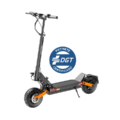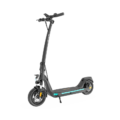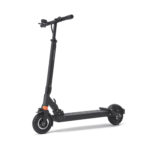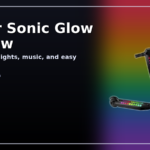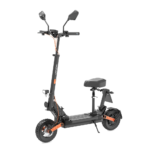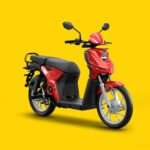- Home
- Scooters
- Electric Scooters
- JOYOR LuxeRider
JOYOR LuxeRider
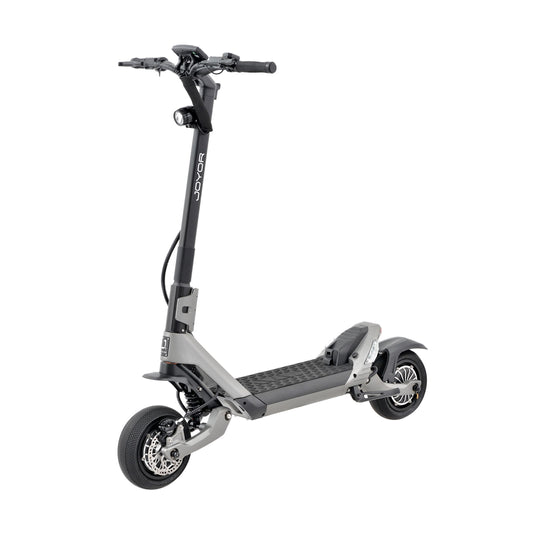

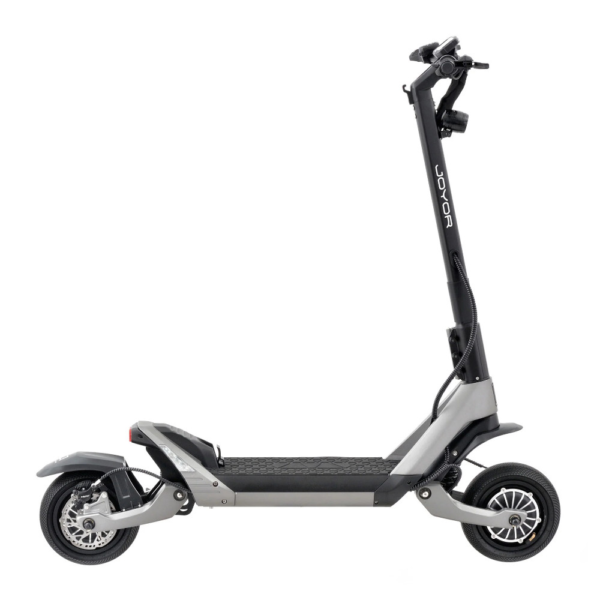
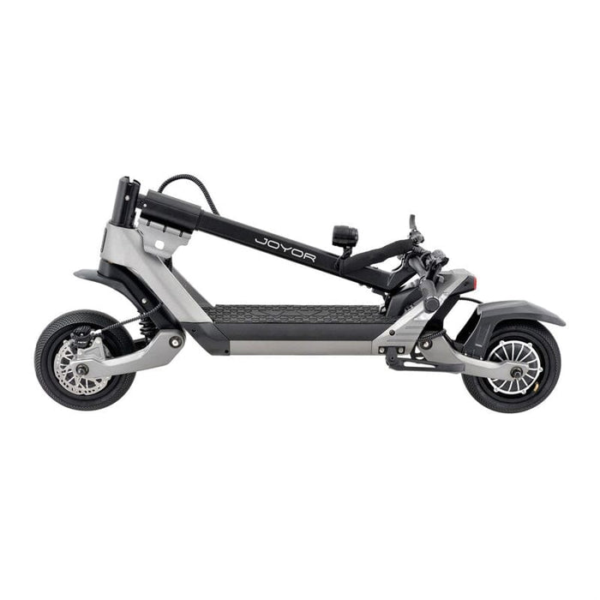
- Battery Range: 60 km
- Top Speed: 55–62 km/h
- Motor Power: 2 × 1200 W nominal
- Weight Capacity: 150 kg
- Charging Time: ~7 h
- Scooter Weight: 40 kg
PROS
- Dual-motor acceleration and hill power
- Hydraulic discs front & rear
- Tubeless 10×3.0 tires reduce flats
- Turn signals + full lighting
- Double suspension comfort
CONS
- Heavy to lift upstairs
- High speed not for public roads
- Tubeless tires still need pressure care
- Stronger pace reduces range
The JOYOR LuxeRider blends big-motor punch with a polished ride and a travel-ready chassis. It targets riders who want confident acceleration, hydraulic braking, and a stable platform without moving up to oversized off-road machines. As a result, it suits daily commuting and weekend exploring, where comfort and control matter as much as speed.
Because the JOYOR LuxeRider pairs dual motors with a 52 V battery and robust suspension, it feels composed at neighborhood speeds and still has headroom for hill climbs and quick passes. The published data below uses both metric and imperial units so you can judge fit, range, and performance at a glance.
What Is the JOYOR LuxeRider?
The JOYOR LuxeRider is a dual-motor, 52 V performance commuter scooter built around 10-inch tubeless tires, front and rear suspension, and hydraulic disc brakes. It is designed to feel “planted” on imperfect pavement while remaining manageable to carry short distances or load into a car trunk. The platform emphasizes:
- Power on demand: selectable single/dual drive and multi-speed modes.
- Comfort and control: double suspension and wide, grippy 10×3.0-inch tires.
- Real-world utility: integrated lighting with turn signals, a clear LCD, and cruise control.
In short, it’s the brand’s take on a luxury-leaning urban scooter that still sprints like a sport model when you ask.
How the JOYOR LuxeRider Works
At its core, the LuxeRider combines a familiar e-scooter layout with parts tuned for higher output.
- Motors: Two hub motors live inside the wheel hubs. Think of them like compact, sealed “pancake” motors. Because they’re direct-drive, power goes straight to the wheels without chains or belts, which reduces maintenance and response lag.
- Controller: The controller is the scooter’s brain. It meters current from the battery to the motors and decides how strongly to respond when you twist the throttle. It also governs speed modes and the hand-off between single and dual-motor operation.
- Battery: A 52 V, 21 Ah lithium pack sits in the chassis. Voltage (52 V) helps deliver brisk acceleration; capacity (21 Ah) determines how long you can ride between charges.
- Throttle: A thumb or trigger throttle (model-specific housing) sends a signal to the controller. Gentle input equals smooth roll-on; a full press calls for maximum current in the selected mode.
- Brakes: Hydraulic disc calipers at both wheels clamp metal rotors. Because hydraulic systems use fluid pressure rather than cables alone, lever feel is firmer and more consistent over long descents.
- Assist features: Cruise control holds a steady pace on flats. Multi-speed modes cap acceleration and top speed for different environments. Turn signals improve communication in traffic.
Everything happens under the hood, yet the experience is simple: choose a mode, press the throttle, and the scooter translates battery energy into forward motion while suspension and brakes keep you in control.
Key Specifications
Below is a clean, organized table using official data, with metric values followed by imperial conversions.
| Section | Item | Value (Metric) — (Imperial) |
|---|---|---|
| General | Model | JOYOR LuxeRider |
| Wheel size & type | 10 × 3.0 in tubeless pneumatic tires (approx. 254 × 76 mm) | |
| Drive | Dual hub motors (front + rear) | |
| Ride modes | ECO / STD / TURBO (published targets ~17 km/h / 35 km/h / 60 km/h ≈ 10.6 mph / 21.7 mph / 37.3 mph) | |
| Performance & Power | Nominal motor power | 2 × 1200 W (combined 2400 W) |
| Peak motor power | 2 × 1600 W (combined 3200 W) | |
| Max speed (published) | 55–62 km/h — 34–38.5 mph | |
| Climb ability (published) | Up to 45° (real-world grades discussed below) | |
| Battery, Charging & Electrical | Battery | 52 V × 21 Ah lithium (≈ 1,092 Wh) |
| Estimated range | Up to 55–60 km — 34–37 mi (mode-dependent) | |
| Charge time | ≈ 7 hours | |
| Display | Multifunction LCD | |
| Cruise control | Yes | |
| Build & Dimensions | Unfolded size (L×W×H) | 1310 × 627 × 1285 mm — 51.6 × 24.7 × 50.6 in |
| Folded size (L×W×H) | 1300 × 210 × 580 mm — 51.2 × 8.3 × 22.8 in | |
| Weight | ≈ 40 kg — 88 lb | |
| Max rider load | 150 kg — 331 lb | |
| Frame | Aluminum alloy chassis | |
| Safety & Control | Brakes | Front & rear hydraulic disc |
| Suspension | Front & rear suspension (double) | |
| Lighting | Front & rear lights plus turn signals | |
| Features & Extras | Drive selection | Single / dual motor selection (via controls) |
| Speed levels | 3 selectable (ECO/STD/TURBO) | |
| Cruise Control | Included | |
| Warranty & Compliance | Warranty (EU) | 24 months on electrical parts; battery 12 months or 2,000 km (whichever first). 36 months where mandated locally. |
| Local rules | Availability for public-road use varies by country or city; always check regional regulations. |
Official data summarized above (including power ratings, max speed, battery, dimensions, brakes, suspension, published range, and warranty) comes from JOYOR’s product materials.
Design & Build Quality
The LuxeRider looks purposeful from every angle. The silver aluminum chassis resists flex without feeling buzzy over rough patches. The deck is long and reasonably wide, so you can shift your stance during longer rides. Because the battery sits low in the chassis, weight is centralized and stability improves, especially during quick lane changes.
The stem locks with a straightforward folding joint. Under hand, the bar layout is tidy: a central LCD, familiar brake levers, and mode controls that fall easily under the thumb. As a result, the cockpit feels clean rather than crowded. Moreover, the cabling is routed neatly to avoid snags, and the finish on the welds and fasteners shows care typical of mid-to-upper-tier commuter scooters.
The 10×3.0-inch tubeless tires add real-world comfort and durability. Tubeless construction helps reduce pinch flats and lets you run slightly lower pressures for grip, as conditions allow. Meanwhile, the dual suspension—front and rear—absorbs joints and patched asphalt that would otherwise jolt your knees. Together, the tires and suspension transform everyday roads from “tolerable” to “pleasant.”
Performance Fundamentals
In ECO, the JOYOR LuxeRider starts gently and cruises efficiently. In STD, roll-on throttle adds urgency for urban riding where gaps open and close quickly. In TURBO, the acceleration turns notably stronger; you’ll feel the motors pull with conviction, especially from 10 to 25 km/h (6 to 15 mph). Because dual motors share the work, the scooter steps off smartly without drama.
At speed, the long wheelbase and low battery placement help stability. Even when the pavement waves, the chassis resists wobble better than short-deck, single-motor commuters. Grip the bars lightly, keep your knees soft, and the scooter tracks straight. Consequently, roller-coaster-style undulations feel calmer than you’d expect.
For hills, real-world roads often range between 7–10% grades in cities and suburbs. In single-motor mode, the LuxeRider will climb such hills steadily; in dual-motor mode, it feels unfazed, provided you carry momentum and weigh within the rated load. While the published 45-degree climb figure is a marketing-style peak, the practical takeaway is this: most neighborhood climbs are well within its comfort zone when you select the right mode and keep your speed up.
Battery, Range & Efficiency
A 52 V, 21 Ah pack (≈ 1,092 Wh) sits at the heart of the JOYOR LuxeRider. Voltage supports brisk motor response; capacity sets the ride time. The published range up to 55–60 km (34–37 mi) assumes lighter riders, warm temperatures, modest speeds, and smooth surfaces. In everyday mixed riding with stops, hills, and cooler weather, expect less—especially in TURBO or dual-motor use where current draw is higher.
What actually affects range?
- Rider mass: Heavier riders push more current through the system.
- Speed mode: Higher speed equals higher air drag and exponentially higher consumption.
- Terrain: Hills require energy; gravel or rough asphalt adds rolling losses.
- Temperature: Cold batteries deliver less capacity; hot days increase tire rolling resistance.
- Tire pressure: Under-inflation wastes energy; over-inflation reduces grip and ride quality.
Charging best practices
- Let the pack rest a few minutes after a hard ride before plugging in.
- For daily use, charge to 80–90% if you don’t need full range, and avoid leaving it at 100% for days.
- Store around 40–60% state-of-charge in a cool, dry place if you won’t ride for several weeks.
- Inspect the charger leads periodically; clean dust from ports gently.
With these habits, you enhance pack longevity while keeping day-to-day range predictable.
Ride Quality & Comfort
Comfort is where the LuxeRider earns its name. The tubeless 10×3.0-inch tires provide a generous contact patch and soak up chatter that skinny commuter tires transmit. Meanwhile, front and rear suspension flatten cracked pavement, expansion joints, and the odd cobblestone section. The suspension is tuned toward the “supportive” side: it avoids pogoing, yet it still feels active enough over repetitive bumps.
Ergonomically, the deck length allows staggered feet or a side-by-side stance at low speed. Because the stem height suits average riders well, you avoid hunching over. Stem flex is modest for the class and, combined with the wide deck, makes longer rides less tiring. Add cruise control on extended bike-path segments, and your right hand gets a welcome break.
Braking & Safety Features
Hydraulic disc brakes front and rear provide crisp, linear deceleration. Initial bite comes after a short lever pull; add pressure and the stopping force ramps smoothly without chatter. On clean pavement, you can brake firmly without skids if you stay centered over the deck. In rain, ease into the levers so the pads sweep off moisture before demanding peak force.
Lighting is comprehensive. The scooter includes front and rear lights and turn signals, which improve communication with pedestrians and drivers. Because turn signals can be overlooked in daylight, consider hand signals in bright sun for redundancy. Reflective clothing and helmet accents remain smart additions for pre-dawn or dusk rides.
Ingress protection is not specified in the official materials. Therefore, ride conservatively in heavy rain, avoid deep puddles, and dry the scooter after wet rides. Wipe the rotors lightly and cycle the brakes a few times so pads regain consistent feel.
Portability & Daily Usability
At ≈ 40 kg (88 lb), the JOYOR LuxeRider is not a featherweight. However, the folded footprint of 1300×210×580 mm (51.2×8.3×22.8 in) slides behind a car’s rear seats or into a wagon trunk. For stairs, carry in short bursts with a stable two-hand grip—one on the stem and one under the deck.
The fold latch is straightforward, and the bars clear most doorways when rolled. Because the deck height is moderate, the center of gravity stays low while walking the scooter, which helps in tight hallways and elevator entries. For daily storage, a floor stand or wall hook keeps the tires round and the deck tidy. Lastly, for security, use a solid U-lock or heavy chain through the deck or a secure frame point; never rely on a cable alone.
Maintenance & Care
A light schedule prevents small issues from turning into downtime.
Before each ride (30–60 seconds)
- Check tire pressure (follow the sidewall range; adjust for weight and surface).
- Squeeze both brake levers; feel for consistent pressure.
- Scan for loose bolts, especially at the stem hinge and axle nuts.
- Confirm lights and turn signals work.
Weekly
- Inspect brake pads for wear and glazing; adjust calipers if rub appears.
- Check spokes (if applicable to wheel design) and rotor bolts for tightness.
- Wipe the deck and clean the display face.
Monthly
- Examine suspension hardware and bushings; look for play or leaks.
- Check alignment: roll the scooter and ensure the bar is straight relative to the wheel.
- Review battery charge habits; balance charge to 100% occasionally to keep cells even.
Seasonally
- Rotate tires front to rear if wear patterns differ.
- Clean and re-lubricate any exposed pivot points in the folding mechanism.
- Inspect chargers and cables; replace frayed leads.
Because the LuxeRider uses hydraulic brakes, plan pad replacement on a normal road-use interval. If the lever feel ever goes spongy after a fall or long storage, a professional bleed may restore firmness.
Weather & Seasonal Considerations
Rain reduces traction and lengthens braking distances. Therefore, lower your speed, extend your following gap, and brake progressively. Paint lines and metal covers become slick; cross them upright.
Cold (below ~10 °C / 50 °F) diminishes available battery capacity. You may see a noticeable range drop on winter-morning commutes. Warm the scooter indoors before riding, and keep speeds modest; both help battery efficiency.
Heat raises tire pressures and can stress batteries if you park in full sun after a ride. Let the scooter cool in shade before charging. Moreover, re-check pressures after large temperature swings to stay in the safe window for grip and comfort.
Wind matters more than most riders expect. Headwinds demand extra power; tailwinds inflate range. On gusty days, keep a loose grip and bend your elbows so the front end tracks without overcorrection.
JOYOR LuxeRider vs Alternatives
Within its class, the LuxeRider shines as a balanced dual-motor commuter rather than an extreme off-road rig or a featherweight last-miler.
- Versus compact commuters: It accelerates faster, climbs better, and stops harder thanks to hydraulic brakes. However, it weighs more and is less convenient for multi-flight stair carries.
- Versus big-chassis performance scooters: It’s easier to store and steer in dense areas, and the tubeless 10-inch tires feel lively. On the other hand, supersized platforms may deliver longer range and bigger suspension travel for rough trails.
- Versus single-motor mid-range models: Dual-motor traction provides stronger corner exits and hill starts. Yet, single-motor options often win on price and weight.
If you’re cross-shopping long-range commuters with plush suspension, also consider the Segway Ninebot P100S as a reference point while you evaluate the LuxeRider’s strengths.
Who the JOYOR LuxeRider Is (and Isn’t) For
Ideal for:
- Urban and suburban commuters who want strong braking and headroom for hills.
- Students and professionals who value comfort on cracked city asphalt.
- Weekend explorers who ride mixed paths and appreciate cruise control on longer stretches.
- Heavier riders up to 150 kg (331 lb) who need a sturdier frame and dual-motor torque.
Not ideal for:
- Frequent flyers on public transit who must carry up multiple stairs daily.
- Trail-only riders seeking long-travel suspension and knobby tires.
- Ultra-budget shoppers who can accept slower acceleration and cable brakes to save weight and cost.
FAQs
1) How fast is the JOYOR LuxeRider in real use?
In TURBO with dual motors, the scooter feels rapid to neighborhood limits and beyond, with a published top speed of 55–62 km/h (34–38.5 mph). Always ride within local rules and conditions.
2) What range should I expect day to day?
The published up-to figure is 55–60 km (34–37 mi). Mixed urban riding with stops, hills, and cooler temperatures will reduce that. Plan conservatively and keep pressures dialed.
3) Does the LuxeRider have cruise control?
Yes. Cruise control helps on steady bike-path segments and long commutes.
4) What makes hydraulic brakes desirable here?
Hydraulic systems provide stronger, more consistent lever feel and require less hand force for the same deceleration—useful on longer descents or wet days.
5) Can the LuxeRider climb steep hills?
For typical 7–10% neighborhood grades, yes—especially in dual-motor mode. Approach very steep ramps with momentum and pick smoother lines.
6) Is there a JOYOR LuxeRider overview I can skim first?
This entire article serves as a JOYOR LuxeRider overview, covering design, power, range, safety, and care in one place.
7) What’s the warranty?
In the EU, electrical parts are covered for 24 months; the battery is typically 12 months or 2,000 km (whichever comes first). Local terms can extend coverage where mandated.
Glossary
- Ah (amp-hours): Battery capacity. Higher Ah generally equals longer ride time.
- Wh (watt-hours): Total energy (V×Ah). Useful for comparing range potential across scooters.
- Controller: The electronic unit that meters power from the battery to the motors.
- Dual motor: A motor in each wheel hub for stronger starts and better hill performance.
- Regen: Electronic regenerative braking that feeds a bit of energy back to the battery (not specified here; hydraulic discs are primary).
- Hydraulic disc brake: A brake system using fluid to press pads onto a rotor, offering firmer feel.
- Stem flex: The small amount of give in the handlebar post under load; excessive flex can feel wobbly.
- IP rating: A code describing water/dust resistance (not specified for this model in the official materials).
- Tubeless tire: A tire without an inner tube; it can be run at slightly lower pressures and resists pinch flats.
- PWM/Current limit: How the controller shapes power delivery for smoothness and protection.
- Peak power: Short-burst maximum output; nominal power is the sustained rating.
- Deck: The standing platform. Size and height affect stability and comfort.
- Grade: Hill steepness. A 10% grade rises 10 m for every 100 m traveled.
- Cutout: A controller-driven shutdown to protect components, typically triggered by faults (avoid by staying within intended limits).
- Sag: Temporary drop in voltage during heavy load; appears as sudden battery percentage dips during hard acceleration.
Final Notes on Fit and Setup
Because the LuxeRider supports a wide rider range, start with a neutral stance and adjust from there. Keep elbows slightly bent, relax your shoulders, and unlock your knees over bumps so the suspension can work. Check tire pressures weekly; they shape ride quality as much as springs and shocks. Finally, pick a speed mode and motor setting that matches your route and weather—power is only an advantage when you can use it safely.
Specifications
General
| Model The Model specifies the exact version or name of the scooter. It helps identify its unique design, features, and specifications within the manufacturer’s product line. Knowing the model makes it easier to compare options, find compatible accessories, or look up support information. | LuxeRider |
| Brand The Brand identifies the manufacturer or company that designs and produces the scooter. A trusted brand is a sign of quality, reliability, and good customer support. Well-known brands often have higher standards for safety, performance, and after-sales service, giving you more confidence in your purchase. | JOYOR |
| Release Date The Release Date indicates when the scooter model was officially launched on the market. This helps you know how current the design, technology, and features are. A newer release date often means updated components, improved performance, and the latest safety or smart features. | 17 November 2025 |
| Recommended Age Recommended Age indicates the minimum age range that the scooter is designed for, based on safety, size, and ease of use. Following the recommended age helps ensure that riders can handle the scooter’s speed, weight, and controls comfortably and safely. Always check local laws and use protective gear, especially for younger riders. | Recommended 16+ |
Performance & Power
| Motor Power (Wattage) What it means: The motor power, measured in watts (W), shows how strong the scooter’s electric motor is. Why it matters: Higher wattage usually means better acceleration, more torque, and improved performance on hills or rough terrain. For example, a 250W motor is good for flat city roads and light riders, while a 500W or 1000W motor provides more power for faster speeds or climbing steep inclines. | 2 × 1200 W nominal (2 × 1600 W max) |
| Top Speed The Top Speed indicates the maximum speed that the scooter can reach under optimal conditions. It’s usually measured on level ground with a fully charged battery and an average rider weight. A higher top speed allows you to travel longer distances faster, but always ensure you ride within legal speed limits and your personal comfort zone for safety. | 55–62 km/h (25 km/h limited) |
| Battery Capacity Battery Capacity refers to the total amount of energy the scooter’s battery can store, usually measured in ampere-hours (Ah) or watt-hours (Wh). A higher battery capacity means you can ride longer distances on a single charge, reducing the need for frequent recharging. Keep in mind that actual range can vary depending on rider weight, terrain, speed, and weather conditions. | 52 V 21 Ah |
| Estimated Range per Charge The Estimated Range per Charge indicates the average distance the scooter can travel on a single full battery charge. This range is calculated under optimal conditions, such as flat terrain, moderate speed, and average rider weight. Real-world range may vary depending on riding style, terrain, weather, and load. A longer range means fewer recharges and greater freedom for longer trips. | Up to 60 km |
| Hill Climb Ability Hill Climb Ability describes the maximum incline or slope that the scooter can handle while maintaining stable performance. It’s typically expressed as a percentage or in degrees. A higher hill climb rating means the scooter can tackle steeper hills without losing too much speed or power. Actual climbing performance may vary based on rider weight, battery charge, and terrain conditions. | Up to 45° grades (manufacturer claim) |
| Drive System The Drive System refers to how power from the motor is delivered to the wheels. Electric scooters typically use either a hub motor (directly integrated into the wheel) or a chain/belt drive system. A high-quality drive system ensures smooth acceleration, efficient power transfer, and low maintenance. The choice of drive system affects performance, noise level, and overall ride experience. | Dual hub motors (2WD) |
Charging & Electrical
| Charging Time Charging Time indicates how long it takes to fully recharge the scooter’s battery from empty to 100% using the standard charger provided. Faster charging means less downtime and more time on the road. Actual charging time may vary slightly depending on battery capacity, charger output, and environmental conditions. | Approx. 7 hours |
| Battery Type Battery Type refers to the specific technology used in the scooter’s battery, which affects performance, lifespan, weight, and charging time. Most modern electric scooters use high-quality lithium-ion (Li-ion) batteries because they offer a good balance of energy density, durability, and low maintenance. A reliable battery type ensures consistent power delivery and longer riding ranges. | Lithium-ion pack |
| Removable Battery A Removable Battery means the battery pack can be easily detached from the scooter for convenient charging and replacement. This feature allows you to charge the battery separately, swap it with a spare for extended range, or securely store it indoors in extreme weather. Removable batteries add flexibility and make it easier to keep your scooter powered up wherever you are. | Non-removable internal battery (fixed pack) |
| Regenerative Braking Regenerative Braking is an energy-saving feature that converts some of the energy normally lost during braking back into battery power. When you slow down or brake, the motor works in reverse to generate electricity, which helps extend the scooter’s range and improves overall efficiency. This system also reduces wear on traditional brake components, leading to lower maintenance over time. | Yes |
| Lighting Lighting refers to the built-in front and rear lights that enhance visibility and safety when riding in low-light conditions or at night. Good lighting helps you see the road ahead and ensures that other road users can see you. Many scooters include LED headlights, taillights, and sometimes brake lights or side reflectors for added safety and compliance with local traffic regulations. | Headlight + tail/brake + turn signals + reflectors |
Build & Dimensions
| Scooter Weight Scooter Weight refers to the total weight of the scooter when fully assembled, including the battery. This affects how easy it is to carry, lift, and store the scooter when not in use. A lighter scooter is more portable and convenient for commuting, especially if you need to carry it upstairs or onto public transport. Keep in mind that a sturdy frame and quality components may add to the weight but also contribute to better durability and ride stability. | 40 kg |
| Maximum Rider Weight Maximum Rider Weight indicates the highest rider weight that the scooter is designed to safely support while maintaining optimal performance and stability. Staying within this limit helps ensure reliable acceleration, braking, and climbing ability, and it protects the frame, suspension, and motor from excessive strain. Exceeding the recommended limit may reduce performance and increase wear on components. | 150 kg |
| Deck Size Deck Size refers to the dimensions of the scooter’s standing platform. A wider and longer deck provides more foot space, allowing you to stand comfortably and adjust your stance while riding. A well-sized deck improves balance and stability, especially on longer rides or at higher speeds. Compact decks, on the other hand, help keep the scooter lightweight and portable. | Wide deck; long, stable stance |
| Handlebar Height Handlebar Height refers to the distance from the deck to the handlebars, which affects your riding posture and comfort. An appropriate handlebar height helps you maintain good balance, reduces strain on your back and arms, and makes steering more comfortable. Some scooters have adjustable handlebars to fit riders of different heights, while others have a fixed height for a streamlined design. | Adult fixed bar height |
| Folding Mechanism The Folding Mechanism describes how easily and securely the scooter can be folded for carrying and storage. A well-designed folding system lets you quickly collapse the scooter into a compact size, making it convenient to transport on public transit, store under a desk, or fit into a car trunk. Look for sturdy latches and safety locks to ensure the scooter stays firmly in place when folded or unfolded. | Reinforced folding latch |
| Dimensions Folded Dimensions indicate the size of the scooter when it’s fully folded. This measurement shows how much space the scooter will take up when stored or carried, making it easier to check if it will fit in your car trunk, under a desk, or in a closet. Compact folded dimensions are ideal for commuters who need to bring their scooter on public transport or store it in tight spaces. | 1300 × 210 × 580 mm (folded) |
| Material Material refers to the primary construction materials used for the scooter’s frame and key components. High-quality materials like aircraft-grade aluminum, reinforced steel, or durable composites provide strength, stability, and a lighter overall weight. A sturdy material ensures the scooter can handle daily wear and tear while maintaining safety and performance. | Aluminum alloy frame |
Safety & Control
| Brake Type(s) Brake Type(s) describe the braking systems the scooter uses to help you slow down or stop safely. Common brake types include mechanical brakes (like drum or disc brakes), electronic brakes, and foot brakes. Many scooters combine multiple braking systems for added safety and shorter stopping distances. The type and quality of brakes affect your control, especially when riding at higher speeds or on slopes. | Hydraulic discs front & rear |
| Suspension Suspension refers to the system that absorbs shocks and vibrations while riding, providing a smoother and more comfortable ride over uneven or rough surfaces. Scooters may have front suspension, rear suspension, or dual suspension for better shock absorption and stability. Good suspension helps reduce rider fatigue and improves control, especially when riding on bumpy roads or off-road paths. | Front & rear, double suspension |
| Tire Type Tire Type refers to the kind of tires the scooter uses, which directly affects ride comfort, traction, and maintenance. Common types include solid (airless) tires, pneumatic (air-filled) tires, or hybrid options. Pneumatic tires offer better shock absorption and a smoother ride on rough surfaces, while solid tires are puncture-proof and require less upkeep. The right tire type helps ensure safe handling and a comfortable ride in different conditions. | Tubeless pneumatic (street/all-terrain) |
| Tire Size Tire Size indicates the diameter and width of the scooter’s tires, which affect ride comfort, stability, and how well the scooter handles different terrains. Larger tires generally offer better shock absorption and a smoother ride over bumps and rough surfaces, while smaller tires keep the scooter lighter and more portable. Choosing the right tire size helps ensure a balance between agility and comfort. | 10 × 3.0 in (6.5 rim) |
| Kickstand The Kickstand is a built-in stand that allows you to park your scooter upright when it’s not in use. A sturdy kickstand keeps the scooter stable and prevents it from tipping over, protecting it from scratches and damage. It also makes storing and accessing your scooter more convenient, whether you’re at home, work, or on the go. | Side kickstand |
| Water Resistance Rating Water Resistance Rating indicates how well the scooter is protected against water and moisture, usually shown as an IP (Ingress Protection) rating. This rating helps you understand whether the scooter can handle light rain, splashes, or wet roads without damage. While most scooters are not fully waterproof, a good water resistance rating adds peace of mind when riding in changing weather conditions. Always avoid deep puddles or submerging the scooter to protect its electrical components. | IP54 body |
Features & Extras
| Display/Console The Display (or Console) shows important real-time information about your ride, helping you monitor your scooter’s status at a glance. Typical displays show speed, battery level, distance traveled, and riding mode. Some models also include additional features like Bluetooth connectivity, app integration, or backlighting for better visibility at night. A clear and easy-to-read display enhances safety and convenience on every trip. | Multifunction LCD dashboard |
| Ride Modes Ride Modes refer to the different speed and power settings you can choose to match your riding style or road conditions. Common modes include eco for maximum range and energy efficiency, standard for everyday balance, and sport or turbo for higher speed and stronger acceleration. Switching between ride modes allows you to customize performance, conserve battery, and ride safely in various environments. | Eco (17 km/h), STD (35 km/h), Turbo (60 km/h) |
| Smart App Connectivity Smart App Connectivity lets you pair your scooter with a dedicated mobile app via Bluetooth. Using the app, you can monitor real-time ride stats like speed, battery level, and range, adjust settings such as ride modes or cruise control, lock the scooter for added security, and sometimes receive firmware updates. This feature adds convenience and allows you to personalize your riding experience right from your smartphone. | App-free basic operation |
| Anti-Theft System The Anti-Theft System helps protect your scooter from unauthorized use or theft. This feature can include built-in alarms, electronic motor locks, GPS tracking, or remote locking through a mobile app. A good anti-theft system provides peace of mind when parking your scooter in public spaces, adding an extra layer of security to safeguard your investment. | N/A |
| Cruise Control Cruise Control allows you to maintain a steady speed without continuously holding the throttle. This feature makes longer rides more comfortable by reducing hand fatigue and providing a smoother, more relaxed riding experience — especially on flat, open roads or bike lanes. For safety, cruise control can usually be easily activated or deactivated while riding. | Yes (cruise control) |
| Accessories Included Accessories Included lists the additional items that come with the scooter to enhance your riding experience and convenience. Common accessories may include a charger, kickstand, bell, lights, phone holder, or carrying strap. These extras add value by making your scooter safer, easier to use, and ready to ride straight out of the box. | Bell, reflectors, charger |
Warranty & Compliance
| Warranty Period The Warranty Period indicates how long the manufacturer guarantees the scooter against defects in materials and workmanship under normal use. A good warranty provides peace of mind, showing the brand’s confidence in its product quality. Always check what parts are covered, such as the frame, battery, and motor, and follow the maintenance guidelines to keep your warranty valid. | 24 months on electrical parts; 12 months/2000 km battery (36 months in Spain) |
| Certifications Certifications confirm that the scooter meets specific safety, quality, and environmental standards set by recognized organizations or regulatory bodies. Common certifications may include CE, RoHS, UL, or other local compliance marks, depending on your region. These certifications ensure that the scooter is manufactured to high standards and is safe and legal to use in your country. | Not approved for public roads in Spain or Germany (private areas only) |


